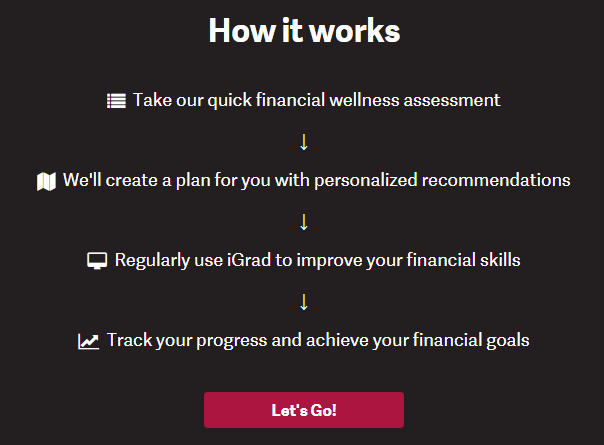How to Tackle Paying Off Student Loans after Graduation
As I have stated before, graduation is coming very quickly (in less than 2 months), so the thought of having to start repaying my student loans is always on my mind.
The overwhelming thoughts of where to see my loans, how much I owe, what my monthly payments will be, how long it will take me to pay them back, etc. do not have to be as daunting as they currently are!
American Eagle Credit Union offers super helpful financial education tools and resources so I can make informed decisions about college financing options, including repayment. iGrad offers educational articles, tools and courses that allow me (and you!) to become prepared for life before and after college. And, best of all … it’s free!
In my case, after college, I turned to iGrad to start preparing for life on my own.
I created an account and personalized my settings by answering a few simple questions so iGrad could recommend tips and tools based on my responses. The goal of iGrad is to “feel financially empowered by learning how to manage your money and repay your loans.”
iGrad provides information on topics such as Managing Money, Paying for School, Finding a Career.
In my case, and for this blog, I focused on Paying for School > Repaying Student Loans
The article that caught my eye, “Know what Student Loan Amounts You Owe” (which also has a video tutorial), states the obvious: I need know how much I owe before I can choose which payment plan best fits my total. This also includes knowing the interest!
The National Student Loan Data System (NSLDS) tracks all federal student loans. It will tell you: Loan Type (subsidized or unsubsidized), Loan Amount, and even the Amount Outstanding owed. Once I logged on, I was able to see the total amount of subsidized and unsubsidized. Whew! And, not only do I personally have federal loans, I also have parent PLUS loans will be transferred to my name once I graduate.
After I figured out how much I owed, I searched of the type of repayment options that would best fit me. Options include:
Standard: Fixed Monthly Payments over 10 years. This has larger monthly payment but offers a lower interest rate (which saves you money in the end).
Graduated: Monthly payments start lower and increase every 2 years with a 10 year period.
Extended Repayment Plan: 25 years (minimum of $30,000 loan debt)
Income-Driven: Revised Pay As You Earn (REPAYE), Pay As You Earn (PAYE), Income-Contingent Repayment (ICR), Income-Based Repayment (IBR).
Now that I have a true picture of just what I owe, it was time to review Debt Management Strategies. The five strategies iGrad recommends are:
Prepayment: One of the best things you can do! Paying accrued interest before repayment begins. This reduces your total amount before repayment starts. And, once you do begin repaying your loans, consider paying MORE than your monthly payment (if you have the extra money).
Changing repayment plans: If you feel payment plans are too high or low, contact your lender to find a plan that works best for your situation.
Loan consolidation: Choose from a single monthly payment, an extended repayment schedule, and, if/when necessary, loan forgiveness.
Consulting your Loan Provider: Your lender is there to answer any questions regarding your loans.
Loan Forgiveness Programs: Research the Public Service Loan Forgiveness (PSLF) and understand all options of Student Loan Forgiveness to determine if you qualify.
After spending just a few hours of my afternoon in iGrad I feel so much more confident with where I stand as graduation approaches. Not knowing the total amount of loans I had, or my repayment options was such an uneasy feeling. I feel more calm and ready to tackle these loans once my grace period is over.
Take a few minutes and sign up for iGrad today so you can monitor your loans and learn information before its too late.
Are you ready to get financially prepared? Get started today at https://www.igrad.com/






